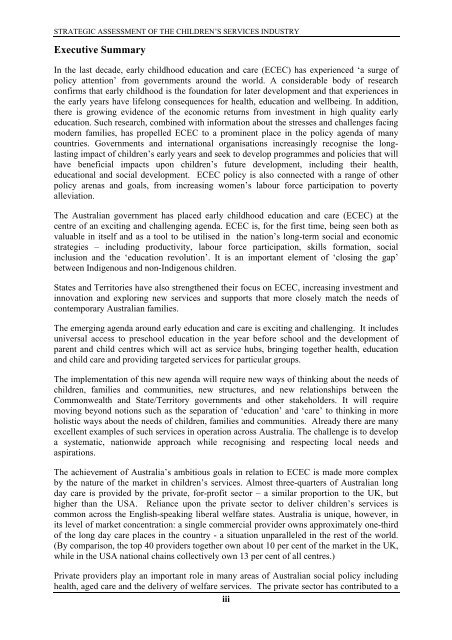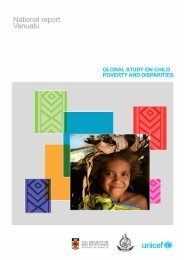A Strategic Assessment of the Children's Services Industry
A Strategic Assessment of the Children's Services Industry
A Strategic Assessment of the Children's Services Industry
- No tags were found...
You also want an ePaper? Increase the reach of your titles
YUMPU automatically turns print PDFs into web optimized ePapers that Google loves.
STRATEGIC ASSESSMENT OF THE CHILDREN’S SERVICES INDUSTRYExecutive SummaryIn <strong>the</strong> last decade, early childhood education and care (ECEC) has experienced ‘a surge <strong>of</strong>policy attention’ from governments around <strong>the</strong> world. A considerable body <strong>of</strong> researchconfirms that early childhood is <strong>the</strong> foundation for later development and that experiences in<strong>the</strong> early years have lifelong consequences for health, education and wellbeing. In addition,<strong>the</strong>re is growing evidence <strong>of</strong> <strong>the</strong> economic returns from investment in high quality earlyeducation. Such research, combined with information about <strong>the</strong> stresses and challenges facingmodern families, has propelled ECEC to a prominent place in <strong>the</strong> policy agenda <strong>of</strong> manycountries. Governments and international organisations increasingly recognise <strong>the</strong> longlastingimpact <strong>of</strong> children’s early years and seek to develop programmes and policies that willhave beneficial impacts upon children’s future development, including <strong>the</strong>ir health,educational and social development. ECEC policy is also connected with a range <strong>of</strong> o<strong>the</strong>rpolicy arenas and goals, from increasing women’s labour force participation to povertyalleviation.The Australian government has placed early childhood education and care (ECEC) at <strong>the</strong>centre <strong>of</strong> an exciting and challenging agenda. ECEC is, for <strong>the</strong> first time, being seen both asvaluable in itself and as a tool to be utilised in <strong>the</strong> nation’s long-term social and economicstrategies – including productivity, labour force participation, skills formation, socialinclusion and <strong>the</strong> ‘education revolution’. It is an important element <strong>of</strong> ‘closing <strong>the</strong> gap’between Indigenous and non-Indigenous children.States and Territories have also streng<strong>the</strong>ned <strong>the</strong>ir focus on ECEC, increasing investment andinnovation and exploring new services and supports that more closely match <strong>the</strong> needs <strong>of</strong>contemporary Australian families.The emerging agenda around early education and care is exciting and challenging. It includesuniversal access to preschool education in <strong>the</strong> year before school and <strong>the</strong> development <strong>of</strong>parent and child centres which will act as service hubs, bringing toge<strong>the</strong>r health, educationand child care and providing targeted services for particular groups.The implementation <strong>of</strong> this new agenda will require new ways <strong>of</strong> thinking about <strong>the</strong> needs <strong>of</strong>children, families and communities, new structures, and new relationships between <strong>the</strong>Commonwealth and State/Territory governments and o<strong>the</strong>r stakeholders. It will requiremoving beyond notions such as <strong>the</strong> separation <strong>of</strong> ‘education’ and ‘care’ to thinking in moreholistic ways about <strong>the</strong> needs <strong>of</strong> children, families and communities. Already <strong>the</strong>re are manyexcellent examples <strong>of</strong> such services in operation across Australia. The challenge is to developa systematic, nationwide approach while recognising and respecting local needs andaspirations.The achievement <strong>of</strong> Australia’s ambitious goals in relation to ECEC is made more complexby <strong>the</strong> nature <strong>of</strong> <strong>the</strong> market in children’s services. Almost three-quarters <strong>of</strong> Australian longday care is provided by <strong>the</strong> private, for-pr<strong>of</strong>it sector – a similar proportion to <strong>the</strong> UK, buthigher than <strong>the</strong> USA. Reliance upon <strong>the</strong> private sector to deliver children’s services iscommon across <strong>the</strong> English-speaking liberal welfare states. Australia is unique, however, inits level <strong>of</strong> market concentration: a single commercial provider owns approximately one-third<strong>of</strong> <strong>the</strong> long day care places in <strong>the</strong> country - a situation unparalleled in <strong>the</strong> rest <strong>of</strong> <strong>the</strong> world.(By comparison, <strong>the</strong> top 40 providers toge<strong>the</strong>r own about 10 per cent <strong>of</strong> <strong>the</strong> market in <strong>the</strong> UK,while in <strong>the</strong> USA national chains collectively own 13 per cent <strong>of</strong> all centres.)Private providers play an important role in many areas <strong>of</strong> Australian social policy includinghealth, aged care and <strong>the</strong> delivery <strong>of</strong> welfare services. The private sector has contributed to aiii
















